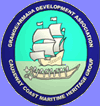| de Cuellar Trail |
| Sligo |
| Causeway Coast |
|
|
 |
The de Cúellar Armada Trial - Causeway Coast |
|
|
Click
on the map to find out more about the areas de Cúellar's visited
on his travels. |
|
| Giant’s Causeway (8) ( Map | Dunluce | Castleroe | Binevenagh | Magilligan ) | |

|
|
| It
was at the Giant’s Causeway that de Cúellar hoped to rendezvous with
La Girona, the flagship of the Armada’s Naples Division. However,
being over a day late, he missed the vessel and it’s well that he
did for the ship foundered and almost all her complement was lost.
De Cúellar heard the news with great sorrow.
“I went to the huts of some of the savages <Irish> that were there, who told me of the great misfortunes of our people who were drowned at that place and showed me many jewels and valuables of theirs, which distressed me greatly.” |
|
| Dunluce
Castle (9) ( Map
| Giant's Causeway
| Castleroe | Binevenagh
| Magilligan ) |
|
|
 |
|
| Following
the sinking of La Girona, de Cúellar stayed in the area for a time.
He must have been extremely close to Dunluce Castle, the stronghold
of Sorley Boy MacDonnell. The MacDonnells of North Antrim had no great
love for English authority in Ireland. Sorley Boy had given shelter
to five survivors of La Girona. Even so, de Cúellar felt uneasy in
the area.
“My
chief cause of misery was that I had no means of embarking for the
Kingdom of Scotland until one day I heard of the territory of a
savage whom they called Prince Ocan <O'Cahan> where there
were some vessels that were going to Scotland. Thither I traveled,
crawling along, for I could |
|
| Castleroe
(10) ( Map |
Giant's Causeway
| Dunluce | Binevenagh
| Magilligan )
The O’Cahan village of Castleroe lay close to the English garrison post of Coleraine. It was widely regarded as a hotbed of insurrection and consequently, the English military kept a very close eye on affairs there. With no way to Scotland, de Cúellar felt trapped. The people were, however, kindly allowing him to rest in one of the cabins until his leg healed. Then he set out to speak to the O’Cahan chieftain. “he did not wish to see or hear me, for he said, he had given his word to the great Governor of the Queen not to keep any Spaniard in his territory or permit one to go about in it. The English.....having marched off to invade a territory and take it, Ocan accompanied them with all his force so that one could go openly about the village which was composed of thatched huts. In them there were some very beautiful girls with whom I was very friendly” |
|
| Binevenagh
(11) ( Map |
Giant's Causeway
| Dunluce | Castleroe
| Magilligan )
As
de Cúellar’s position became more dangerous, he was forced to leave
Castleroe and head north. The Bishop of Derry, Redmond Gallagher,
was reputedly sympathetic towards shipwrecked Spaniards and might
provide him with transport to Scotland. On top of a mountain overlooking
the Derry Coast <believed to be Benevona> “I
had arrived at a very large laguna |
|
| Magilligan
Point (12) ( Map
| Giant's Causeway
| Dunluce | Castleroe
| Binevenagh )
With the assistance of Gallagher, de Cuellar found passage to Scotland, leaving Ireland from Magilligan Point. From Scotland, he sailed for Flanders in one of four small boats. As they approached Dunkirk, they were bombarded by Dutch mercenaries who held the coast. Only two boats managed to get through and once again, de Cúellar had to stagger ashore. Secretly, he watched as 270 Spaniards were massacred by the Dutch, leaving only 3 alive. Finally he arrived in Antwerp where he was able to write an account of his amazing journey. “We blessed God who withdrew us from such perils and so great hardships and brought us to a land where there might be more succour.” |
|

